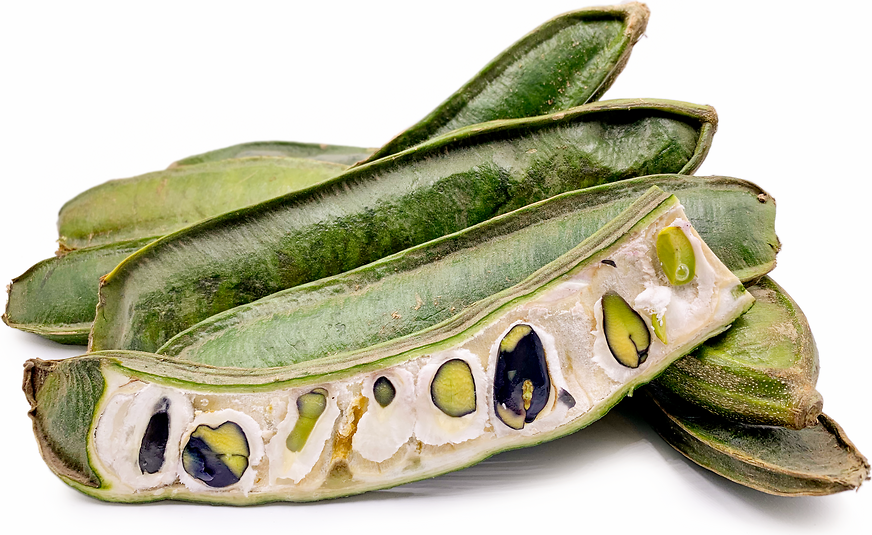


Pacay Fruit
Estimated Inventory, lb : 0
Description/Taste
Pacay trees grow up to 18 meters in height and produce elongated, cylindrical pods that hang from the branches. The dark green pods vary in size, averaging 3 to 30 centimeters in length, and can be straight to slightly curved with a thick, leathery consistency. Inside the pod, a white, cotton-like pulp with a spongy texture encases multiple smooth, black seeds. The number of seeds varies depending on the pod's size, and large pods may contain as many as 20 seeds. Pacay fruit's chewy, white pulp is edible when fresh and has a subtly sweet flavor reminiscent of vanilla. The black seeds are not edible when raw and must be cooked before consumption, developing a mild, nutty flavor.
Seasons/Availability
Pacay fruits are available in the summer through early winter, also known as the rainy season in South America.
Current Facts
Pacay fruits, botanically classified as Inga feuillei, are a variety of ice cream bean belonging to the Fabaceae or legume family. There are over 350 species found within the Inga genus that are similar in appearance, growing leathery pods with sweet flesh, and due to their similarities, many species are often mistaken for one another. In local markets, the pods are also generally labeled, and the name ice cream bean is used interchangeably between the species. Pacay fruits are an ancient legume found in tropical and subtropical climates throughout South America, especially in the Andean states, and are also known as Guaba, Shimbillo, and Guama. The elongated pods are primarily consumed as a sweet snack, but chefs have also begun using the cotton-like pulp and seeds as a flavoring in innovative culinary applications.
Nutritional Value
Pacay fruits are a source of calcium, phosphorous, and iron, which are minerals that contribute to bone and teeth growth. The pods also contain some ascorbic acid, also known as vitamin C, to boost the immune system and protect the body against external environmental damage. In traditional South American medicines, Pacay fruits are believed to increase digestion, reduce stomach irritations, and act as an anti-inflammatory.
Applications
Pacay fruits are best suited for fresh applications as the pulp’s subtly sweet flavor and cotton-like consistency is showcased when consumed straight, out-of-hand. The pods can be broken open by hand, and the pulp can be eaten raw, removing the seeds. In addition to fresh applications, the pulp can be blended into beverages, including smoothies, cocktails, and juices, or it can be used to flavor ice cream and sorbet. Pacay fruits can also be incorporated into desserts, such as mousse, nougat, and candy, or blended into dressings for salads. The seeds are inedible when raw, but they can be boiled in salted water and consumed as a snack, or they can be cooked, ground into a powder, and scrambled into eggs. Pacay seeds can also be roasted, ground and fried into pancakes, or cooked and dried for extended use. Pacay fruits pair well with spices such as cinnamon, allspice, cloves, ginger, and cardamom, vanilla, chocolate, caramel, and fruits such as mango, pear, strawberries, and coconut. Whole Pacay pods will keep for 3 to 5 days when stored in the refrigerator.
Ethnic/Cultural Info
In South America, Pacay trees are valued beyond their edible pods and are an ornamental addition to home gardens, parks, and city squares. The trees are considered visually attractive with wide-spreading branches and elongated, hanging pods, and are often planted by themselves to showcase their unique appearance. In addition to ornamental uses, Pacay trees have a functional role in plantations to provide ample shade for coffee and tea plants. When the trees are planted, the roots also add nitrogen to the soil, providing natural fertilizer for the plantation crops. Pacay trees are a supplementary source of income for plantation farmers as they can sell the green pods in local markets when in season. They can also use the trees as firewood or lumber for construction.
Geography/History
Pacay fruits are native to South America, where it has been cultivated for thousands of years. The pods are depicted on Incan pottery, and seed remnants were found in tombs dating back to 1000 BCE. In South America, experts believe Pacay may have originated in the Andean highlands and was carried to coastal regions of Ecuador and Peru, where it was planted as both an ornamental and food source. Today Pacay fruits are localized to its growing regions in South America and is sold fresh in markets. The other species belonging to the Inga genus that are often mistaken for Pacay can be found in the broader region of tropical and subtropical locations throughout South America, Central America, Mexico, and the Caribbean.
Recipe Ideas
Recipes that include Pacay Fruit. One
| Comida Peruana |
|
Pacay Ice Cream |
| Como Lo Puedo Hacer |
|
Pacay (Guama) Jelly |












